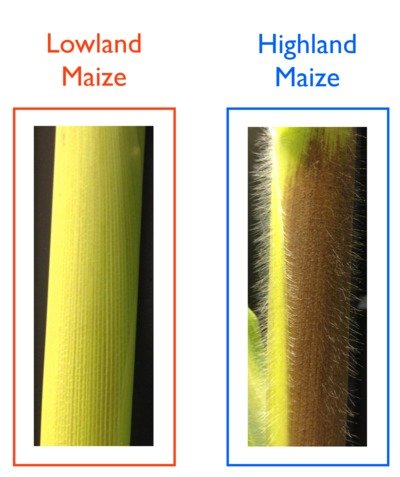Press Release: The Genomic Signature of Crop-Wild Introgression in Maize
Introgression or genetic exchange between crops and their wild relatives is of broad interest due to concern regarding the escape of transgenes from genetically engineered crops. Many fear the potential deleterious effects of such introgression including decreased fitness or diversity of wild relatives and/or the creation of “superweeds” that are resistant to the current arsenal of herbicides. But there is another side to crop-wild gene exchange. A paper published in the open-access journal PLoS Genetics this week reveals that crop-wild introgression is likely a longstanding and potentially beneficial phenomenon in some agroecosystems. Matthew Hufford, Jeffrey Ross-Ibarra and colleagues describe how introgression from wild relatives has shaped the genome of corn, potentially providing essential adaptations as it spread from a narrow center of domestication into novel environments.
Corn was domesticated in the lowlands of southwest Mexico ~10,000 years ago from a wild grass known as teosinte. A few thousand years later corn colonized the high altitudes of the Mexican Central Plateau. There, it came into contact with a different wild teosinte, one presumably well adapted to the new environment. Both corn and teosinte in the highlands have characteristics such as purple pigmentation and hairy stalks and leaves that are believed to help these plants tolerate the lower temperatures and higher ultra-violet radiation of the highlands. For some time, biologists have been stumped as to whether corn and teosinte obtained these highland adaptations independently or through introgression, with some arguing that the shared characteristics were a good example of maize genes escaping into the wild.

Through analysis of genetic markers from across the corn genome, Hufford and co-authors provide evidence that the shared characteristics of teosinte and highland corn are due to introgression, but with gene exchange occurring predominantly in one direction — from the wild teosinte into corn. Introgression was particularly common in regions of the genome previously linked to highland adaptation traits. When corn with and without introgression in these genomic regions was grown at low temperature, plants with teosinte introgression showed pigmentation and hairy leaves, consistent with highland adaptation, whereas those without introgression lacked these traits. These results suggest that the successful spread of corn to the highlands may have been enabled by gene exchange with highland teosinte.
In contrast, regions of the corn genome selected by early farmers during domestication appeared particularly resistant to introgression in either direction of gene flow, indicating continued selection against wild traits in corn as well as selection against corn genes in the wild teosinte.
In addition to corn, a number of crops have spread from small domestication centers into novel environments, often populated with locally-adapted wild relatives. The work by Hufford and coauthors suggests genomic data in other systems may reveal that introgression from wild relatives has provided crops with adaptations such as drought tolerance, acclimation to extreme temperature and disease resistance. Rather than focus solely on the biosafety aspects of crop-wild introgression, we can also begin to assess how crop-wild introgression may have contributed to — and continue to be harnessed for — crop improvement.
Reference: Hufford MB, Lubinksy P, Pyhäjärvi T, Devengenzo MT, Ellstrand NC, et al. (2013) The Genomic Signature of Crop-Wild Introgression in Maize. PLoS Genet 9(5): e1003477. doi:10.1371/journal.pgen.1003477
